13.3 Fractures, Joints, and Faults
When rocks break in response to stress, the resulting break is called a fracture. If rocks on one side of the break shift relative to rocks on the other side, then the fracture is a fault. If there is no movement of one side relative to the other, and if there are many other fractures with the same orientation, then the fractures are called joints. Joints with a common orientation make up a joint set (Figure 13.19).
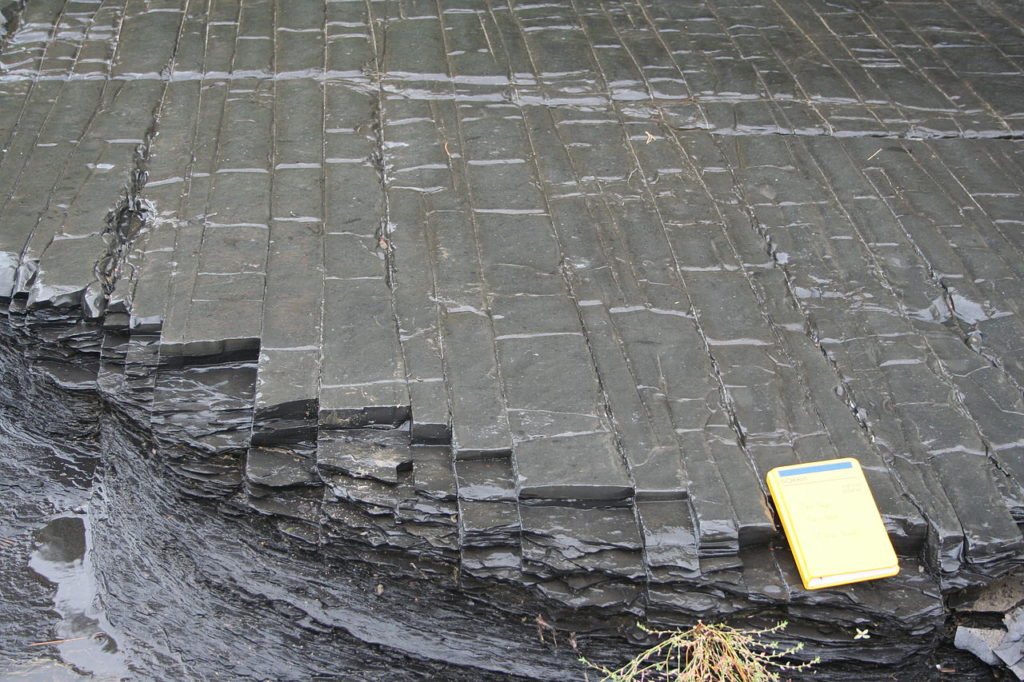
Jointing
Most joints form when the overall stress regime is one of tension (pulling apart) rather than compression. The tension can be from a rock contracting, such as during the cooling of volcanic rock (Figure 13.9, upper left). It can also be from a body of rock expanding. Exfoliation joints, which make the rock appear to be flaking off in sheets (Figure 13.20), occur when a body of rock expands in response to reduced pressure, such as when overlying rocks have been removed by erosion.
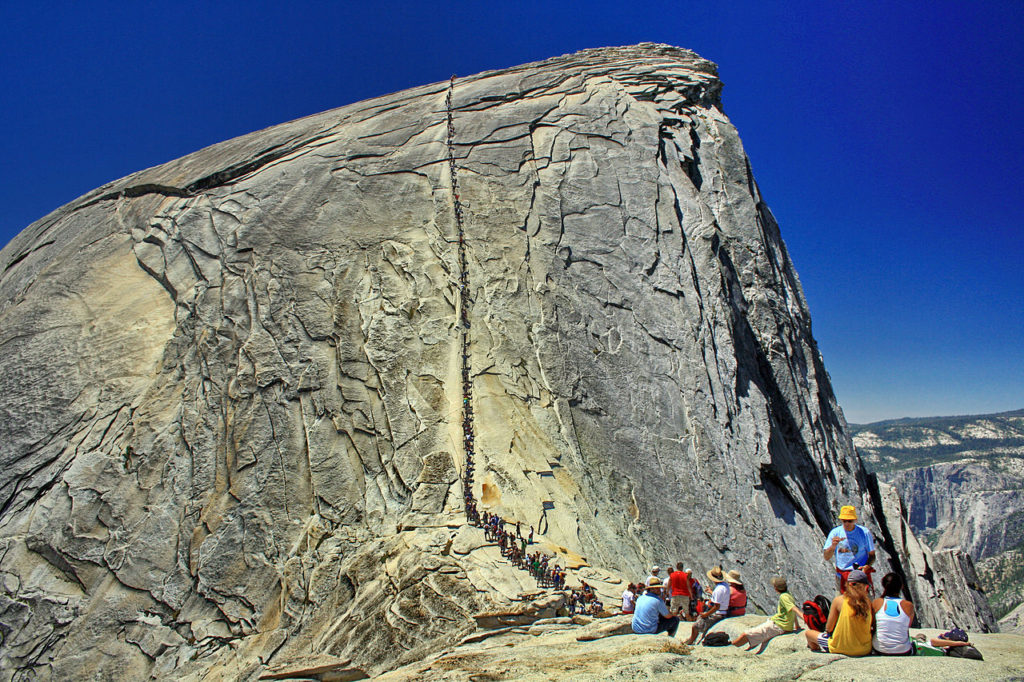
Nevertheless, it is possible for joints to develop where the overall regime is one of compression. Joints can develop where rocks are being folded, because the hinge zone of the fold is under tension as it stretches to accommodate the bending (Figure 13.21).
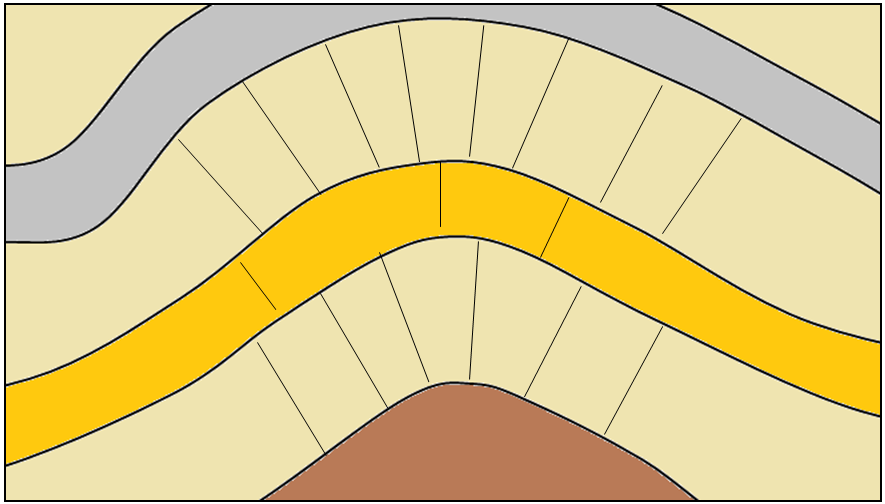
Joints can also develop in a rock a rock under compression as a way to accommodate the change in shape (Figure 13.22). The joints accommodate the larger compression stress (larger red arrows) by allowing the rock to stretch in the up-down direction (along the green arrows).
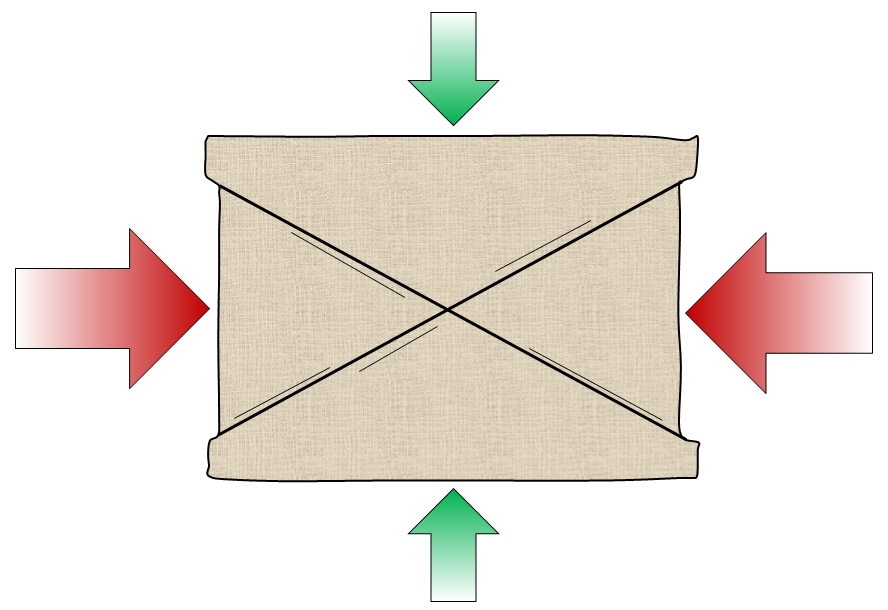
Faulting
A fault is a boundary between two bodies of rock along which there has been relative motion (e.g., Figure 13.23). Some large faults, like the San Andreas fault in California or the Tintina fault, extending from northern British Columbia through central Yukon and into Alaska, show evidence of hundreds of kilometres of motion. Other faults show only centimetres of movement. In order to estimate the amount of motion on a fault, it is necessary to find a feature that shows up on both sides of the fault, and has been offset by the fault. This could be the edge of a bed or dike as in Figure 13.23, or it could be a landscape feature, such as a fence or a stream.
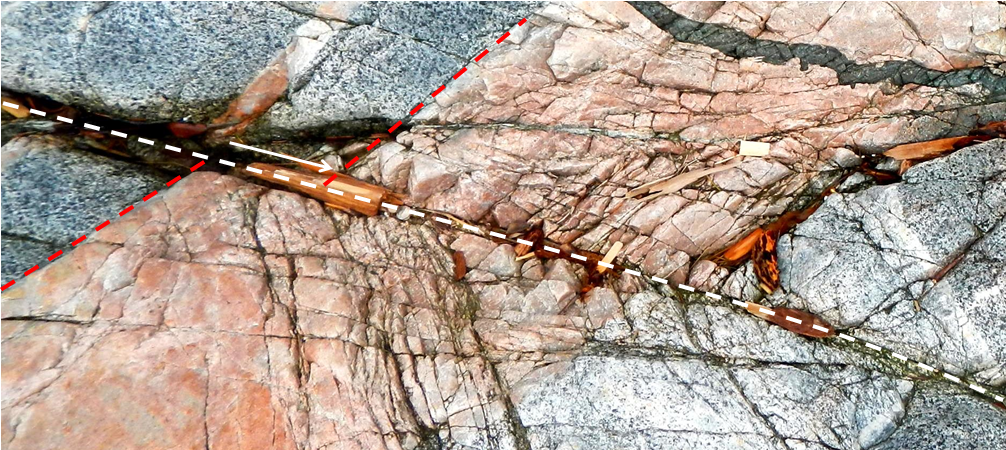
Types of Faults
Different kinds of faults develop under different stress conditions. We describe faults in terms of how the rocks on one side of the fault move relative to the other.
Dip-Slip Faults
Dip-slip faults are so named because the dominant motion involves moving up or down the dipping (tilting) fault plane. In dip-slip faults we identify rock above the fault as the hanging wall, (or headwall) and the rock beneath as the footwall. These terms were originally used by miners to describe the rocks above and below an ore body (Figure 13.24).
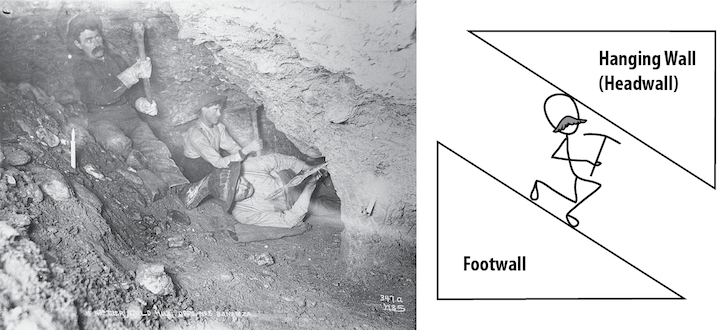
Tension produces normal faults, in which the crust undergoes extension. This permits the hanging wall to slide down the footwall in response to gravity (Figure 13.25, left). Compression produces reverse faults, pushing the hanging wall up relative to the footwall. Reverse faults shorten and thicken the crust (Figure 13.25, right).
Strike-Slip Faults
Faults where the motion is mostly horizontal and along the “strike” or the length of the fault are called strike-slip faults (Figure 13.26 bottom). These happen where shear stress causes bodies of rock to slide sideways with respect to each other, as is the case along a transform boundary. If the far side moves to the right, as in Figures 13.23 and 13.26 (right), it is a right-handed, right-lateral,or dextral strike-slip fault. If the far side moves to the left it is a left-handed, left-lateral, or sinistral strike-slip fault.
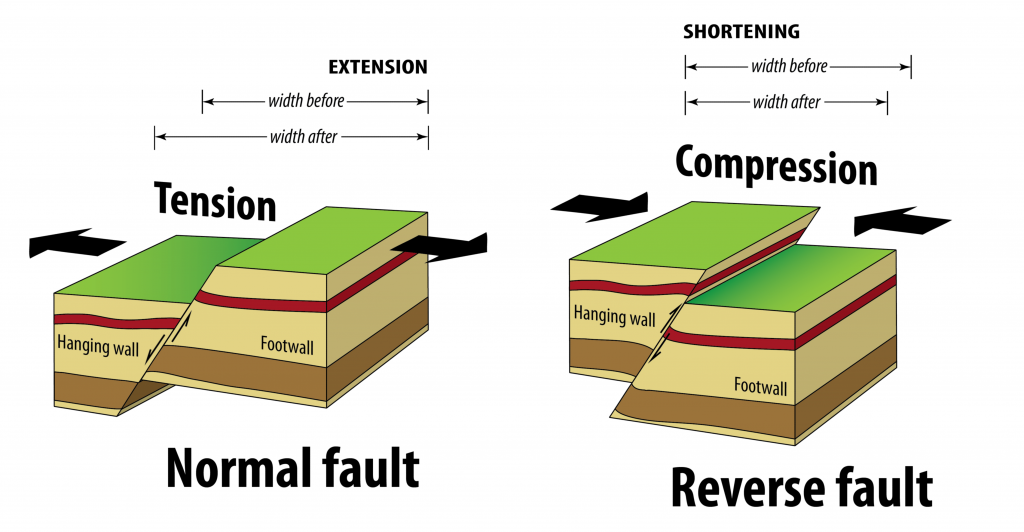
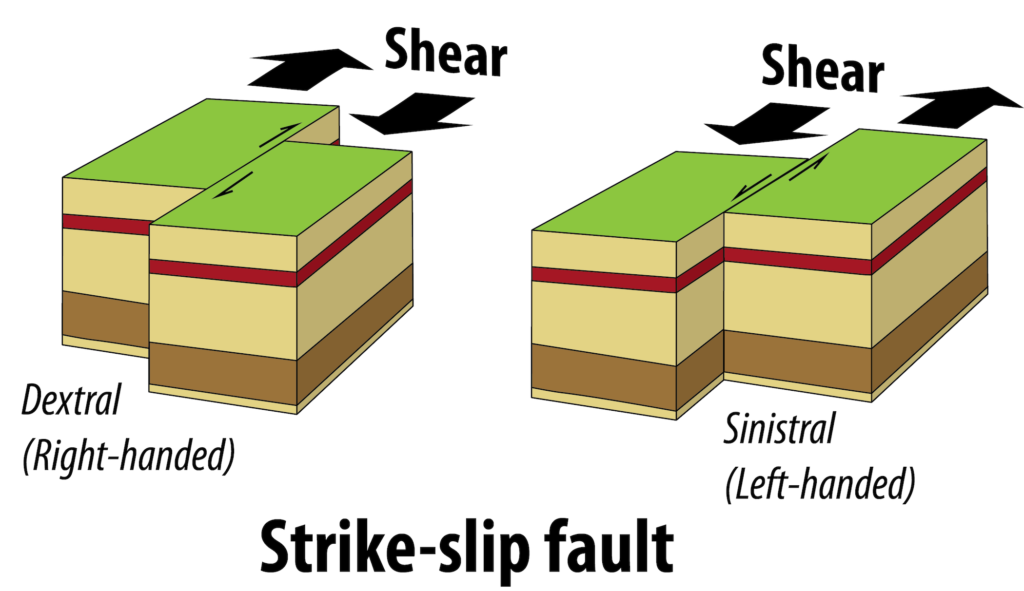
Different Tectonic Settings Have Distinct Types of Faults
Horst and Graben Structure
In areas that are characterized by extensional tectonics, and with many normal faults arranged side-by-side, some blocks may subside (settle downward) relative to neighbouring parts. This is typical in areas of continental rifting, such as the Great Rift Valley of East Africa or in parts of Iceland. In such situations, blocks that move down relative to the other blocks are graben, and elevated blocks with graben on either side are called horsts. There are many horsts and graben in the Basin and Range area of the western United States, especially in Nevada. Part of the Fraser Valley region of British Columbia, in the area around Sumas Prairie, is a graben.
![Figure 12.14 Depiction of graben and horst structures that form in extensional situations. All of the faults are normal faults. [SE]](https://openpress.usask.ca/app/uploads/sites/29/2017/05/graben-and-horst-structures.png)
Thrust Faults
Thrust faults are a type of reverse fault with a very low-angle fault plane. The fault planes of thrust faults typically slope at less than 30°. Thrust faults are relatively common in mountain belts that were created by continent-continent collisions. Some represent tens of kilometres of thrusting, where thick sheets of sedimentary rock have been pushed up and over other layers of rock (Figure 13.28).
![Figure 12.15 Depiction a thrust fault. Top: prior to faulting. Bottom: after significant fault offset. [SE]](https://openpress.usask.ca/app/uploads/sites/29/2017/05/thrust-fault.png)
There are numerous thrust faults in the Rocky Mountains, and a well-known example is the McConnell Thrust, along which a sequence of sedimentary rocks about 800 m thick has been pushed for about 40 km from west to east over underlying rock (Figure 13.29). The thrusted rocks range in age from Cambrian to Cretaceous, so in the area around Mt. Yamnuska Cambrian-aged rock (around 500 Ma) has been thrust over, and now lies on top of Cretaceous-aged rock (around 75 Ma) (Figure 13.30).
![Figure 12.16 Depiction of the McConnell Thrust in the eastern part of the Rockies. The rock within the faded area has been eroded. [SE]](https://openpress.usask.ca/app/uploads/sites/29/2017/05/McConnell-Thrust.png)
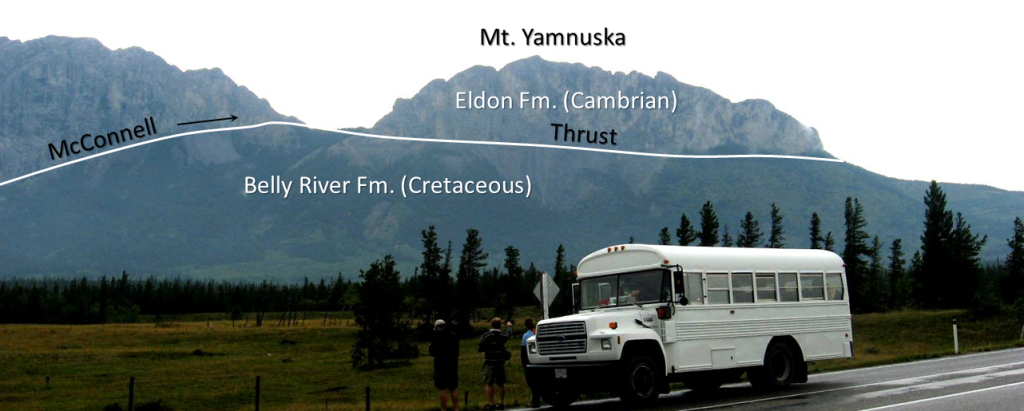
Exercise: Fault Types

